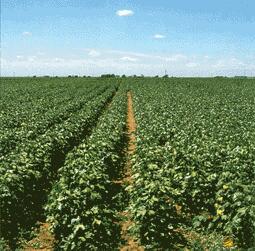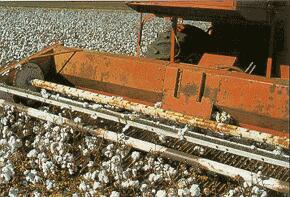By Pamilyn Scott

Photo courtesy of Russ Perkins
Ultra narrow-row cotton is becoming more popular across the High Plains as more farmers discover its advantages. By producing cotton in 10-inch or narrower rows and increasing the density of plant populations, more cotton is grown per acre at a lower cost.
Russ Perkins, field biologist with BASF Corporation, has researched and explored various avenues concerning ultra narrow-row cotton (UNRC) production as opposed to conventional farming. Perkins knows the benefits of UNRC and has witnessed growth in production throughout the High Plains
“The growth has been exponential,” Perkins says. “Everyone is getting involved, from chemical companies and seed dealers to producers.”
With UNRC, seeding rates and final plant populations are increased significantly. UNRC yields 80,000 to 100,000 plants per acre compared to 40,000 to 50,000 using conventional farming. Plant spacing is more uniform, and cotton grown in ultra narrow rows is a more upright, columnar plant with more first-position bolls, few vegetative branches and extremely short fruiting branches, which improves stripper harvest efficiency. Ultra narrow-row cotton produces very little low quality bolls since it aims for producing larger and better quality first-position bolls. If properly managed, UNRC can produce 20 percent more first-position bolls. With UNRC,the fruiting cycle also is condensed to two weeks as opposed to four with conventional, notes Perkins.

Harvesting costs are lowered by use of a stripper harvester with a broadcast head allowing cotton to move between the fingers and removing cotton bolls. Photo courtesy of Russ Perkins
“The herbicide pattern used for UNRC is similar to those used for conventional farming,” Perkins explains. There are herbicides that provide control for broadleaf weeds while others are available to control grass. Cotton varieties tolerant to certain herbicides offer their use for broadleaf weed control. Summer weeds are shaded out with early row closure, and a solid crop canopy prevents late weed growth.
Harvesting improvements have been made even though there are still some limitations. UNRC requires precision drilling for exact seed placement. To harvest, a farmer needs a standard cotton stripper fitted with a broadcast head since few companies have developed and marketed a finger harvester. All models use the concept of fingers made from angle iron, mounted to a central point and tilted at 15 to 20 degrees. Cotton plants move between the fingers and cotton bolls are removed as the machine progresses forward. A “kicker-bar” is placed above the platform on most models to help remove cotton bolls and move cotton from the platform to the auger. The addition of a saw-type cleaner (field cleaners) to remove sticks, burrs and other trash greatly increases the efficiency and allows stripper harvested cotton to be ginned at facilities generally accepting picker harvested cotton. Another advantage is that a stripper harvester costs approximately half that of a traditional picker. Daily operating costs are about one-third that of a picker, and lower maintenance costs increase the return on investment.
Ultra narrow-row cotton offers other benefits like being suitable for all tillage systems, works with most soils and topographies, reduces erosion and weed pressure, controls equipment and labor costs and produces better quality cotton.
The research of UNRC in the High Plains began in 1995 with Perkins, but BASF did not want to be the only one conducting research, so other prospective producers were brought in.
“We had to involve producers, Texas Tech, the experiment station, extension service, and the USDA to make the idea work,” Perkins says. “It couldn’t be only BASF.”
If planting UNRC is to expand in the High Plains, it is important to expose UNRC to producers to give them the opportunity to actually see and understand the benefits it offers.
“We’re planning on having a demonstration plot at the Farmer Stockman Show,” Perkins says. “We have also held a meeting in Lubbock to discuss UNRC. Panelists who have used UNRC explained the process required and their experience to the approximately 85 people in attendance.”


